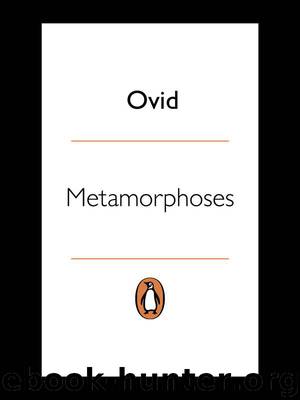Metamorphoses: A New Verse Translation by Ovid

Author:Ovid
Language: eng
Format: azw3, epub
ISBN: 9780141906256
Publisher: Penguin Books Ltd
Published: 2004-01-28T16:00:00+00:00
Book 9
Hercules is the key figure in the next group of stories. Acheloüs and Hercules (1–97) is a lively account of how the river-god fought with the hero for the hand of Deïanira and acquired his broken horn. The next two episodes, Hercules and Nessus (98–133) and The Death of Hercules (134–272), are so obviously based on Sophocles’ play The Women of Trachis that we may think of Ovid here as doing his ‘Sophocles turn’. The poet’s narrative displays his usual vividness, but he concentrates more on the gorier details than on the tragic situation of Hercules’ betrayed wife, Deïanira (he had to some extent explored this previously in Heroides 9). Furthermore, he uses the hero’s immolation and apotheosis as the occasion for a satirically pompous speech from Jupiter, which some may find the most enjoyable passage in the whole of this section.
The humorous tone continues in Alcmena and Galanthis (273–323), which tells the story of Hercules’ birth. Dryope (324–93) is similarly lightweight: there is a kind of schmaltzy pathos in the tale of the girl who picks a water plant to amuse her baby and is turned to a lotus tree herself. In Iolaus and Callirhoe’s Sons (394–417) we have two metamorphoses involving human age, one of rejuvenation, the other of acceleration. The passage is (for us) rather tiresomely allusive and only intelligible with explanatory notes; but it does enable Ovid to work in some more of the standard Theban legend. Miletus (418–52) gives us the pleasure of another pompous speech from Jupiter and takes us on, by an artificial transition, to one of Jupiter’s sons, our old friend Minos, who is now very old and in fear of a young rival Miletus – who flees from Crete to found a new city in Asia Minor and begets the twins, Byblis and Caunus, who are the subject of the next story.
The rest of the book is superb, with Ovid exploring and entering sympathetically into two cases of what might be considered ‘abnormal’ passions. In Byblis (454–665) he takes a popular Hellenistic Greek story and makes it very much his own. His heroine falls desperately in love with her twin brother, and her feelings are chiefly expressed in three major passages: first a long monologue in which she attempts to justify incest, then in a letter of confession which she pens to Caunus, and finally in a second monologue after her advances have been rejected with horror. Drawn-out and rhetorical as all this may appear, it makes for extremely compelling reading and recitation, and Byblis’ eventual metamorphosis comes across as a naturally contrived and almost consoling conclusion.
Iphis (666 – 797) is hi some ways a parallel story but also a contrast. This explores the predicament of a girl brought up as a boy (to save her from being killed at birth) and later betrothed to a girl with whom she is genuinely in love. Iphis in her monologue is made to perceive her feelings as monstrous and unnatural, ‘a new kind of passion’, a view which may have been shared by some of Ovid’s audience.
Download
Metamorphoses: A New Verse Translation by Ovid.epub
This site does not store any files on its server. We only index and link to content provided by other sites. Please contact the content providers to delete copyright contents if any and email us, we'll remove relevant links or contents immediately.
| Ancient, Classical & Medieval | Anthologies |
| British & Irish | Japanese & Haiku |
| Love Poems | Regional & Cultural |
| Themes & Styles | United States |
| Women Authors |
The Universe of Us by Lang Leav(14364)
The Sun and Her Flowers by Rupi Kaur(13691)
Adultolescence by Gabbie Hanna(8142)
Whiskey Words & a Shovel II by r.h. Sin(7478)
Love Her Wild by Atticus(7229)
Smoke & Mirrors by Michael Faudet(5508)
Wiseguy by Nicholas Pileggi(4585)
The Princess Saves Herself in This One by Amanda Lovelace(4509)
Love & Misadventure by Lang Leav(4354)
Milk and Honey by Rupi Kaur(4226)
Memories by Lang Leav(4170)
Good morning to Goodnight by Eleni Kaur(3805)
Bluets by Maggie Nelson(3707)
Too Much and Not the Mood by Durga Chew-Bose(3693)
Algedonic by r.h. Sin(3499)
Pillow Thoughts by Courtney Peppernell(3393)
The Poetry of Pablo Neruda by Pablo Neruda(3364)
HER II by Pierre Alex Jeanty(3169)
Stuff I've Been Feeling Lately by Alicia Cook(3053)
